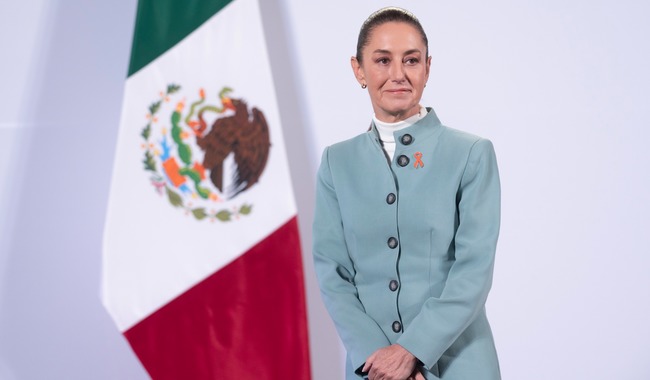
Mexico 2025: Challenges Worsen
The greatest danger to Mexico in 2025 is a large downgrade in its credit rating.
LATINVEX SPECIAL
Center for the U.S. and Mexico at Rice University’s Baker Institute
In 2025, Mexico’s current challenges are likely to worsen, as the recently inaugurated Claudia Sheinbaum Pardo administration (2024–30) has shown an unwillingness to depart from the policy playbook of the Andrés Manuel López Obrador administration (2018–24) — a playbook that has already proven unable to resolve most of the country’s problems. Political and diplomatic relations are headed for a rocky year, as Mexico drifts further away from a strategic allyship position with the United States on several items.
First, Mexico refuses to consider U.S. concerns about China’s economic activities in Mexico. Chinese investment in Mexico — often hidden by layers of companies affiliated in third countries, and likely a strategy by China to secure access to the American market through the United States-Mexico-Canada Agreement (USMCA) — is not well-received in Washington. Additionally, this economic dynamic may become a major irritant in 2025, especially as the review and revision of the USMCA agreement gets underway.
Second, Mexico’s realignment of its foreign policy with Cuba, Venezuela, and Nicaragua will not benefit its relationship to the U.S. Mexico’s friendly ties with these authoritarian governments mean that the U.S. cannot rely on Mexico as a strategic ally in an increasingly uncertain world. This situation could worsen if current Florida Sen. Marco Rubio is confirmed by the Senate as secretary of state during the Trump administration, as he is likely to focus more on Latin America — a region that the Biden administration has consistently overlooked.
Third, the election of President-elect Donald Trump is likely to bring much attention to two items he values — immigration and drug trafficking. While he is not expected to mind any democratic backsliding happening in Mexico, he may threaten tariffs on Mexican goods if President Sheinbaum does not comply with his demand that Mexico close its borders.
Politically, the National Regeneration Movement (MORENA) and its populist political project known as Fourth Transformation (4T) will likely continue to dominate and pursue their nationalist, one-party-rule agenda as well as the continuous destruction of institutions that guarantee both checks and balances and democracy in general. As the opposition is anticipated to be very weak through the year, any real check on MORENA’s power will come from within the governing coalition. However, the coalition is likely to remain stable through 2025 as they push their legislative and regulatory agenda and power concentration in the executive branch. Consequently, Mexico in 2025 is likely to consolidate into a more authoritarian, one-party system and move into a more radical populism position.
In 2025, growth rates between U.S.’ and Mexico’s economies will continue to diverge. Mexico’s economic performance may slow down to a crawl, while the U.S. economy may experience fairly healthy growth. The U.S. economy will be boosted by additional tax cuts proposed by Trump, but Mexico may not necessarily capture the dividends of this turbocharge to the American economy. Mexico may well be one of the lowest-performing economies in Latin America.
Key issues affecting the Mexican economy in 2025:
- Pressure to cut government spending to close a gaping budget deficit. However, given the overall liabilities the Mexican government has undertaken, such cuts are unlikely to happen. Although domestic consumption will be propped up by cash transfer programs and remittances, it will not substitute strong internal growth. In fact, consumption is likely to remain weak over the year as well.
- Slow down of foreign direct investment. Constitutional changes to the judicial branch and the purposeful weakening of the regulatory environment have caused an erosion of trust and introduced uncertainty for foreign investment.
The greatest danger to Mexico in 2025 is a large downgrade in its credit rating. This can occur if analysts view a significant deterioration in the country’s institutions, including the loss of independence of the judicial branch after the elections of June 2025, and the elimination of the independent regulatory agencies slated for the end of 2024. This downgrade will make Mexico less attractive to capital and investment in general and increase interest on debt and expenditures in debt servicing in the future. This will worsen if Brazil regains its credit rating and if Mexico becomes the object of an investment downgrade. The year 2025 is also the year when most of the activity to review and revise the USMCA will shape up. If there is no consensus on the trade agreement early on, uncertainty may further discourage foreign direct investment through 2025.
The Mexican economy itself will face some additional challenges. Private investment is expected to decrease, and public investment is also likely to shrink in 2025. The peso will continue to slide downward slowly over 2025, due to capital flight — large and small — and the relative attractiveness of the dollar under the new Trump administration. Also, as the economy slows down and revenue becomes tight, the government may be unable to meet its now constitutionally sanctioned liabilities in the form of cash transfer programs, which entail:
- Heavy subsidies to the parastatal enterprises, including Pemex, Federal Electricity Commission (Comisión Federal de Electricidad, CFE), the Felipe Ángeles International Airport (AIFA), the Mayan Train (Tren Maya), Mexican State Airline (Mexicana de Aviación), etc.
- Expensive organization of judge, magistrate, and Supreme Court justice elections.
- Costs of other public services and demands, which are expenses that will likely prevent the budget deficit from being closed in 2025.
- Growing cash transfer programs and skyrocketing pension commitments.
Inflation will likely continue at higher levels than that of most Organisation for Economic Co-operation and Development (OECD) economies. Given Sheinbaum’s commitment not to raise taxes, the Mexican government will both place additional debt in the international markets and try to raise revenue through intimidation tactics by the national revenue collection agency, Tax Administration Service (Servicio de Administración Tributaria, SAT), on industry and businesses. These tactics are likely to discourage further investment and even encourage additional capital flight. Finally, the review and revision of the USMCA will put enormous pressure on Mexico, as the negotiations may involve legislative changes at home that Sheinbaum may not be able to push through Congress.
The 2025 budget establishes a 3.9% deficit, which together with fixed spending, leaves little room for additional investment in four rubrics that will set Mexico back in competitiveness over time.
- Health care: The Mexican health care system is underfunded, understaffed, and increasingly strapped for supplies and drugs.
- Education: Mexico’s investment in education, including fostering skilled labor, will continue to be below what the country needs for its workforce to be competitive.
- Research and development: This is well below the OECD average and falling further behind when compared with its competitors, such as Brazil. No additional funding should be expected in 2025.
- Infrastructure: The year 2025 will be a critical year, as delayed maintenance will accelerate the deterioration of roads, bridges, seaports, airports, land ports, and other strategic infrastructure.
Additionally, Mexico has now completed a counterreform in the energy sector. It has reinstated a model that, while not completely excluding private and foreign investment, favors the national companies. Few energy companies, whether in hydrocarbons or power, are likely to venture into Mexico in 2025 and possibly beyond, if the environment is perceived to be hostile to private and foreign investment. This in turn will discourage larger corporations from considering Mexico as a place to conduct business, especially if they have their own commitments to consume cleaner energy, while Mexico continues to recarbonize its power sector.
Lastly, Sheinbaum has promised to follow former President López Obrador’s strategy on security and public safety. Furthermore, the strategy she has proposed is underwhelming, given Mexico’s declining security and the dismal results between 2018 and 2024, the previous administration’s period. The country will therefore continue to be racked by organized crime and violence, inflicting additional costs on businesses and families and potentially reaching the point of discouraging additional investment if public safety and security is not guaranteed.
This is an executive summary of the reports Mexico Country Outlook 2025 published by the Center for the U.S. and Mexico at Rice University’s Baker Institute.
Republished with permission from the Center.
RELATED ARTICLES












